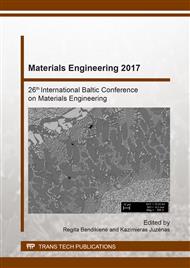p.201
p.207
p.212
p.219
p.224
p.229
p.234
p.243
p.248
Comparative Study of Adhesive Wear for CoCr, TiC-NiMo, WC-Co as Potential FSW Tool Materials
Abstract:
Friction stir welding is a novel and promising joining process and most common welding tool failure is transformation of geometry caused by wear. In our point of view, this is adhesion wear. The lathe testing of adhesion wear was conducted to compare wear resistance of following materials: Co-25wt%Cr, TiC-25wt%Ni/Mo and WC-6wt%Co. According to characteristics of investigated materials, they are capable to become alternatives for conventional frictional stir welding (FSW) tool materials. Adhesive wear tests were performed by turning aluminium alloy AW6082-T6 at low speed – travel length, turning speed and feed rate were selected to simulate FSW conditions. The adhesive wear was determined as the change of the geometry of the cutting edges of the tool measured using SEM images. Most promising tool material in terms of adhesion wear resistance is WC-Co hardmetal. The two main stages of wear were distinguished: at first, the appearance of intensive adhesion wear followed by steady state wear. Surface fatigue wear complements development of the adhesive wear.
Info:
Periodical:
Pages:
224-228
Citation:
Online since:
October 2017
Authors:
Keywords:
Price:
Сopyright:
© 2017 Trans Tech Publications Ltd. All Rights Reserved
Share:
Citation:


